Wise Intention
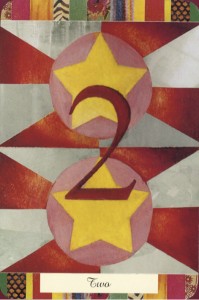 The second factor on the Noble Eightfold Path is samma sankappa, usually translated as Wise (or Right) Intention.
The second factor on the Noble Eightfold Path is samma sankappa, usually translated as Wise (or Right) Intention.
Here’s what Phillip Moffitt has to say, in Dancing with Life:
“In Buddhist terms, practicing right or wise intention means making a commitment to not cause suffering for yourself or others, which requires renouncing those desires that would cause harm. You meet the world with compassion, loving-kindness, generosity, and integrity, and you strive diligently toward liberation. Your wise intention empowers you to align your thoughts, words, and action with your deepest understanding.
“Intention is the pivot point that allows you to dance with life. It is the bridge between understanding and action. Understanding without intention is conceptual and passive, no matter how profound it may be. Wise intention, on the other hand, has an immediate, energetic, attentive quality.
“…There is a big difference between goals and right intention. Your goals are your preferences for the future. Your goals provide inspiration and direction as well as determine how you allocate your time and resources. But your goals do not determine how you act right now. Instead, your intention determines how you actually think, act, and speak in any given moment.
“The following analogy makes clear the distinction between goals and intention. Let’s say you and a friend decide to hike up a mountain. You see the mountaintop and you know that reaching it is your goal–it provides direction and inspiration for the hike. It even informs your preparation and resource allocation–the time you need to set aside, how much water and food you will take along, how you will dress, etc. Therefore, committing to the goal is a vital part of the hike.
“But the actual experience of hiking is very different than reaching your goal, the mountaintop. Your journey up the mountain consists of a series of single steps, rest stops, moments of seeing nature, and sharing companionship. The hike happens in the present moment in each individual step, and each step is primarily defined by your intention. If all you focus on is the goal, you can easily miss being present for the hike.”
Next up: Wise Speech
Wise Understanding
 The first of the eight “folds” of the Buddha’s Eightfold Path is samma ditthi, traditionally translated as Right View or more recently, Right Understanding. But “right” can sound like a value judgment (“I’m right, you’re wrong”), when what is really meant is something closer to “wise,” or “skillful,” even “helpful” or “healthy.”
The first of the eight “folds” of the Buddha’s Eightfold Path is samma ditthi, traditionally translated as Right View or more recently, Right Understanding. But “right” can sound like a value judgment (“I’m right, you’re wrong”), when what is really meant is something closer to “wise,” or “skillful,” even “helpful” or “healthy.”
Here’s what Phillip Moffitt says about this in Dancing with Life:
“I sometimes use the phrase deep understanding instead of wise understanding to highlight the difference between ‘dharma understanding’ and ‘regular knowledge.’ Regular knowledge is surface understanding about events, which allows you to control conditions in order to fulfill your desires. In contrast, cultivating deep understanding enables you to find peace of mind in all circumstances, regardless of whether the surface conditions of your life are pleasant or unpleasant.”
When describing the Eightfold Path, Right View / Wise Understanding is normally listed first, but it’s not something you “do” or “get” and then go on to the next step. It is a way of setting off in the right/wise direction, but it’s also the result of following the Path, because doing so will naturally lead to a deeper, wiser understanding of how to live without suffering.
Here’s what Phillip has to say:
“It is taught that right view is understanding and framing your experience through the Four Noble Truths. Right view is also the understanding that your actions have consequences. Your first encounter with wise understanding may come from a personal experience of suffering so overwhelming that you realize there must be a better way to cope with life. Or it may arise out of an urgent need to find some meaning in your life that while not unhappy, seems superficial….Through wise understanding you clarify what really matters to you and formulate a set of values by which to live.
“Right view comes at the beginning of the Eightfold Path because without realizing that there is dukkha [stress, suffering, some nagging sense of dissatisfaction] in your life and understanding that you can do something about it, you would never be motivated to start. Wise Understanding is also the continuous, cumulative result of practice.
“For this reason, it is useful to think of the Eightfold Path as both a sequence of eight steps that follow one after the other and as an interconnected set of eight energetic practices that relate circularly and directly to one another, such that wherever you start on the path is beginning. Whichever aspect of the Eightfold Path you focus on, you engage all the parts directly or indirectly. And if you explore any of the eight factors in sufficient depth, it will lead you naturally to another.”
Next up: Wise Intention.
Dancing on the Eightfold Path
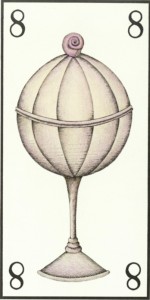 The Monday night “Dancing with Life” KM Group has now started reading/discussing Chapter 20 (of Dancing with Life, by Phillip Moffitt). The chapter is titled: Developing Intention, Your Ally on the Path and it focuses on each of the 8 “factors” of the Noble Eightfold Path. Which are:
The Monday night “Dancing with Life” KM Group has now started reading/discussing Chapter 20 (of Dancing with Life, by Phillip Moffitt). The chapter is titled: Developing Intention, Your Ally on the Path and it focuses on each of the 8 “factors” of the Noble Eightfold Path. Which are:
Wise Understanding
Wise Intention
Wise Speech
Wise Action
Wise Livelihood
Wise Effort
Wise Mindfulness
Wise Concentration
Phillip writes: The Noble Eightfold Path is not a set of beliefs or laws but rather a practical, direct experience method for finding meaning and peace in your life.
Think of it as an organic blueprint from which you organize and live your life. Each of the path factors defines one aspect of behavioral development needed for you to move from suffering to joy. Its eight factors function as an integrated system or matrix that supports and informs all parts of your life.
[The Buddha said the Four Noble Truths of suffering and the end of suffering must be “penetrated to by cultivating the Path.”] By “cultivating,” the Buddha means “attending to, nourishing, and manifesting” each of these factors of wisdom in your life.
***
I’ll post what Phillip has to say on each of these factors over the next eight days. Stay tuned.
(image: Tarot Maddonni)
Well, Then What?
 In an interview with Ajahn Sucitto (available here), Sally and Guy Armstrong ask: “We’ve heard rumors that you’re retiring. Any truth to that?” This question was of particular interest to me because as of today, it’s official: I will retire at the end of this month (from my “day job,” not from the DharmaTown Times!).
In an interview with Ajahn Sucitto (available here), Sally and Guy Armstrong ask: “We’ve heard rumors that you’re retiring. Any truth to that?” This question was of particular interest to me because as of today, it’s official: I will retire at the end of this month (from my “day job,” not from the DharmaTown Times!).
Then they asked this follow-up question, which seems even more pertinent: “Where do you think you might go? Will you go somewhere, or land anywhere?”
Sucitto replies:
We’ll see what causes and conditions come together. I don’t feel I want to be zooming around every which way. These are new topics, new areas for us, whether to stay in the monastery or leave for a few years and just come back and be somewhere in the background. I don’t know.
And as a practice, it’s good not to know. I mean, because you spend so much of your time just popping the soap bubbles of fantasy, that after a while you can’t really blow ’em that hard, thinking: “Oh, I want to be in the idyllic…” You know, we’ve been there. Pop. “This is going to be the answer to my life….” Pop.
So I don’t feel like blowing any soap bubbles of fantasies. And then I go to that place of, well, then what? And then I go, well….
Stop.
Let it be open.
“What’ll I do then?”
Stop.
Let it be open.
Because then it really is a change of gear. It’s not just another strategy. It’s just know that life will take care of you — and wing it. Life will take care of you. And then see… just see what seems to be the most beckoning causes and conditions that seem to lead onward.
**
Which is kind of what I have in mind. My last day of work will be August 30. On September 9, I leave for a 6-week retreat at IMS (Insight Meditation Society). Then in January, I go to Burma for a month.
And then what?
Let it be open.
Relax and Be Kind
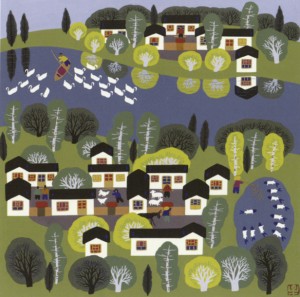 I’ll be away, visiting with family in Door County, Wisconsin, until Wednesday, August 7. So until then, I leave you with this quote from Tibetan master, Nyoshul Khenpo Rinpoche:
I’ll be away, visiting with family in Door County, Wisconsin, until Wednesday, August 7. So until then, I leave you with this quote from Tibetan master, Nyoshul Khenpo Rinpoche:
I would like to pass on one little bit of advice I give to everyone.
Relax.
Just relax.
Be nice to each other.
As you go through your life, simply be kind to people.
Try to help them rather than hurt them.
Try to get along with them rather than fall out with them.
With that, I leave you, and with all my very best wishes.
(image from: Summer Day, watercolor by Chen Lian Zing)
Practicing Practice
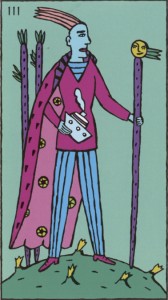 We had a great discussion last night in the Dancing with Life KM group, where basically we acknowledged that in moving toward a life of less suffering, we often have to experience quite a bit more of it. Here’s the passage we discussed (from page 219 of the hardback edition of Dancing with Life, by Phillip Moffitt):
We had a great discussion last night in the Dancing with Life KM group, where basically we acknowledged that in moving toward a life of less suffering, we often have to experience quite a bit more of it. Here’s the passage we discussed (from page 219 of the hardback edition of Dancing with Life, by Phillip Moffitt):
“Walking the Eightfold Path is a humbling undertaking. You will spend a lot of time on various plateaus where nothing seems to be happening in the way of less suffering or more insight.
“Sometimes, as you become more aware of your thoughts and actions, it can actually feel like you are suffering more. When you start to give up behavior that once stimulated, entertained, or distracted you, it can seem as if you’ve made the sacrifice for no good reason.
“Therefore, it is necessary that you learn to love the plateaus. I mean really love them.
“Practicing practice becomes the ground for your journey. Day after day, you find joy, or at least a sense of alignment, by simply practicing each of these eight factors as best you are able. You learn to laugh at the follies of your mind, to stop being self-judging, and to just get back on the path when you have wandered off.”
(image from: Kitty Kahane’s Tarot)
Living and Dying
from The Tibetan Book of Living and Dying, by Sogyal Rinpoche:
 “Above all, be at ease, be as natural and spacious as possible. Slip quietly out of the noose of your habitual anxious self, release all grasping, and relax into your true nature.
“Above all, be at ease, be as natural and spacious as possible. Slip quietly out of the noose of your habitual anxious self, release all grasping, and relax into your true nature.
“Think of your ordinary, emotional, thought-ridden self as a block of ice or a slab of butter left out in the sun. If you are feeling hard and cold, let this aggression melt away in the sunlight of your meditation.
“Let peace work on you and enable you to gather your scattered mind…and awaken in you the awareness and insight of Clear Seeing. You will find your negativity disarmed…and your confusion evaporating slowing like mist into the vast and stainless sky of your absolute nature.”
(image from: kidsforsavingearth.org)
Is This What You Want?
From U Tejaniya, the meditation teacher at Shwe Oo Min monastery in Yangon, where I’ll be staying for a couple of weeks at the end of our trip in January:
 “When does the mind feel tightness or tension?
“When does the mind feel tightness or tension?
“There is tension when the mind wants something other than what is happening or when the mind rejects what is happening.
“Defilements [impediments to peace] don’t want to let things be as they are; they want something to happen, they want results, or they want to control what is happening and they’ll force, focus, create, or restrict to get what they want.”
(image from: Creative What Pack, by Roger von Oech)
Just Stay on the Path
More from Dancing with Life, by Phillip Moffitt:
 “If you continue to practice, the day will come when you realize that the only way life makes any sense with its endless changing cycle of gain and loss, pain and pleasure, is to view it as practice.
“If you continue to practice, the day will come when you realize that the only way life makes any sense with its endless changing cycle of gain and loss, pain and pleasure, is to view it as practice.
“Treating the Eightfold Path as integral practice transforms your everyday life….Skillful living becomes your measure of success, instead of how often you get what you want.
“This is a much better way to view your life! You are more relaxed, flexible, and you even experience more enjoyment. Some of your worldly goals will fall away or diminish in importance, but many will remain, although they are constantly changing.
“The radical difference is that your inner attitude shifts and how you manifest moment by moment as you go about attaining your worldly goals is dramatically different. Your experience of life itself is changed.”
(image from: Kitty Kahane Tarot)
Talk, Talk, Talk
In Chapter 19 of Dancing with Life, Phillip Moffitt reflects on the Eightfold Path, which “is not a list of what to do if you want to become a good person. Rather, it is a matrix of behavior, understanding, and practice for finding peace of mind and meaning in your life.”
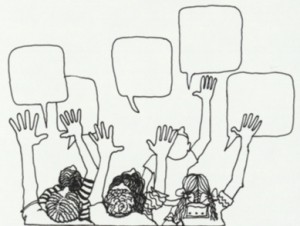 One of these eight “folds” is Right Speech, “which involves saying what is not only true and useful but also timely…”
One of these eight “folds” is Right Speech, “which involves saying what is not only true and useful but also timely…”
“This may sound simple to you, but just wait until you actually try practicing right speech!
“You will discover that much of the time you spend talking serves little or no purpose for you or others. It is simply your brain discharging the pressure you feel through casual, fairly random utterances or running commentary on what you are currently experiencing.
“You quickly discover that speech actually drains you of energy and often creates situations that then demand more of your attention.
“Or you many discover that much of your speech is just a space filler to avoid silence or for the purpose of being entraining when it is not really very interesting to you or the other person.”
Uh oh.
(image from: Creative Whack Pack, by Roger von Oech)
